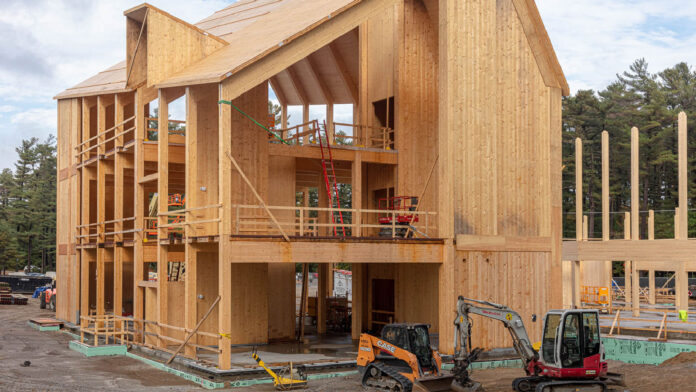On the whole, modern buildings have very large carbon footprints, thanks to pollution-heavy concrete, steel, insulation, and more. Indeed, according to the United Nations Environment Programme, “The buildings and construction sector is by far the largest emitter of greenhouse gases, accounting for a staggering 37% of global emissions.” (Estimates vary but all are high, including for new US residences.) So it’s no surprise that the search is underway for ways to shrink those emissions.
Part of this search involves the recovery and translation of traditional, natural, low-carbon, or even carbon-sequestering building materials, sometimes involving new technologies, sometimes not. The resulting structures range from high-dollar, prize-winning statement designs to refugee shelters that can be built in hours and cost almost nothing. And they are appearing all over the globe, from Sweden to Bangladesh, Ghana to Colorado, though still in small numbers.
These developments are mostly written about in scientific research papers, trade and professional journals, company blogs, and books by leading theorist-practitioners, rather than in mainstream newspapers and magazines, so the pieces collected here are just a sampling. Some of the more engaging stories are those featuring individual innovators who combine art, architecture, technology, a concern for the environment and climate change, respect for cultural history and specificity, and a goal of making their work practical, scalable, and genuinely good for the planet.
Building with earth
- “The woman who brought dirt to Harvard.” Michaela Haas, Reasons to be Cheerful. A portrait of artist/architect Anna Heringer, who specializes in earth/clay building, notably in Bangladesh. Her 13-minute TED talk, “The warmth and wisdom of mud buildings,” is very good.
- “Traditional building practices offer sustainable solutions as African cities grow.” UNEP.org. The featured architect, Francis Kéré, who comes from and works in Burkina Faso, wrote this piece for the NYT: “In building the future, a blueprint from the past.” With the caption “Moderating the dialogue between the traditional and the modern in the search for a new architecture for Africa,” Kéré describes the cultural, historical, and conceptual contexts in which he works.
- “Ronald Rael constructs an architecture of the borderlands with 3D-Printed Adobe and Regional histories.” Joshua Ware, Southwest Contemporary. Another artist/architect doing conceptually and culturally rich work, this time with very new technology.
- “Retrospective: Martin Rauch.” Marko Sauer and Gabriela Carrilo, The Architectural Review. This influential ceramicist-turned-builder has experimented with rammed earth, first for walls, then increasingly large and complicated buildings.
- “‘I said to myself, dirt doesn’t burn’: The people rebuilding their homes with earth.” Nick Aspinwall, BBC.
Building with bamboo: strong and fast-growing
Building with abundant plant fibers
Building with wood: “mass” or “engineered” timber
- “The trees and the forest of new towers” (Stephen Wallis, NYT) and “Sustainable building effort reaches new heights with wooden skyscrapers” (Kurt Kleiner, Knowable Magazine, reprinted here at Yale Climate Connections). These two overviews focus on the potential without ignoring the problems, which can include replacing mature and old-growth forests with plantations. For a purely optimistic view, read “This old-school building material could take over city skylines” (William Booth, Washington Post)
- “Wood, now turbocharged with carbon-capture powers.” Prachi Patel, Anthropocene Magazine. Replacing one ingredient of wood (lignin) can increase strength, durability, carbon storage, even transparency.
- “Rethinking construction: the rise of wood as a sustainable material.” Blaine Brownell, Architect Magazine. Focus on reclaiming and recycling wood to keep the carbon stored as long as possible.
- For a fun tangent, see “World’s first wooden satellite, developed in Japan, heads to space.” Kantaro Komiya and Irene Wang, Reuters.
Only 28% of U.S. residents regularly hear about climate change in the media, but 77% want to know more. Help us bring climate news to more people.




